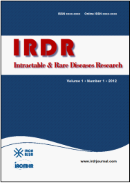Drug Discov Ther. 2022;16(4):177-184. (DOI: 10.5582/ddt.2022.01020)
Trimetazidine improves left ventricular global longitudinal strain value in patients with heart failure with reduced ejection fraction due to ischemic heart disease
Harjoko RP, Sobirin MA, Uddin I, Bahrudin U, Maharani N, Herminingsih S, Tsutsui H
Heart failure with reduced ejection fraction (HFrEF) due to ischemic heart disease (IHD) showed a progressive decline in left ventricular contractile function. However, no previous study has examined the left ventricular global longitudinal strain (LV GLS) parameter that represents LV contractile function. We investigated whether trimetazidine could improve the LV GLS value in patients with HFrEF due to IHD. We performed a double-blind, randomized controlled trial (RCT) including 26 patients with HFrEF due to stable IHD who were given modified-release trimetazidine 35 mg twice per day (n = 13) or placebo (n = 13) for 3 months in addition to standard medication. Left ventricular systolic function including GLS values was assessed at baseline and after 3 months using echocardiography. A total of 25 participants (13 control and 12 trimetazidine groups) were recruited with a baseline average age of 57.1 ± 10 years, and LV ejection fraction (LVEF) value of 34.6% ± 4.4%, and a GLS value of 7.4% ± 2.1%. Baseline clinical characteristics and echocardiogram were similar between the two groups. There was significant GLS improvement in the trimetazidine group (−6.9% ± 2.4% to −8.4% ± 2.6%, p = 0.000), but no significant differences were noted in the control group. The GLS improvement was significantly higher in the trimetazidine group than the control (1.5% + 0.9% vs. −0.7% + 1.7%, p = 0.001). No adverse drug reactions from the administration of trimetazidine in this study. Trimetazidine may improve GLS values in patients with HFrEF due to IHD.







